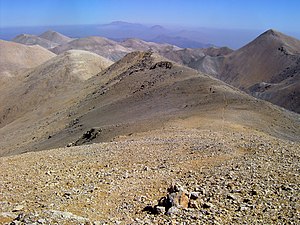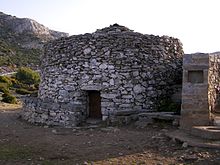Lefka Ori
| Lefka Ori (Λευκά Όρη) | ||
|---|---|---|
|
The summit region as seen from the Pachnes |
||
| height | 2454 m (Pachnes) | |
| location | West Crete , Greece | |
| Coordinates | 35 ° 18 ′ 0 ″ N , 24 ° 2 ′ 0 ″ E | |
|
|
||
| rock | Plate limestone, overlaid by crystalline limestone in the central area | |
| particularities | The summit region is an edaphic desert | |

The Lefka Ori ( Greek Λευκά Όρη , in German the White Mountains , Greek also called Madares (Μαδάρες)) are the largest mountain range in terms of area on the Greek island of Crete . Its highest peak, the Pachnes, is only a few meters lower than that of the Psiloritis massif further to the east of Crete at 2,454 m. The central summit region of the Lefka Ori is one of the few European desert areas .
geography
The Lefka Ori are located in western Crete, south of the city of Chania . The mountain range measures almost 30 km in east-west extension, from the beginning of its northern slopes to the south coast of Crete it is 20 km. Almost the entire mountain range belongs to today's municipality and historical region of Sfakia .
Almost 50 peaks of the Lefka Ori are higher than 2000 m, they enclose over 20 larger gorges, the best known of which is the 13 km long Samaria Gorge , which, starting at Xiloskalo , cuts deep into the western part of the mountains and at Agia Roumeli am Libyan sea ends. In the northwest, the Lefka Ori enclose the Omalos plateau , the second largest plateau in Crete.
The European long-distance hiking trail E4 crosses the whole width of the White Mountains from Agia Irini in the west to Askifou in the east. It runs through the Omalos plateau, then along the northern edge of the Samaria Gorge National Park to the region of the peaks north of the Pachnes, from where it leads past the summit of the Kastro down to the plateau of Askifou .
The high desert
The central part of the Lefka Ori forms an edaphic high desert with almost continuous heights of over 2000 m (Greek Ορεινή Έρημος, 'mountain desert'). Sufficient precipitation falls, especially during the cold season, but when the snowmelts, all the water seeps into the ground immediately, so that the vegetation normally found at this altitude (such as in the neighboring Ida Mountains at the same height ) cannot thrive. The crystalline limestone of this area is extremely susceptible to erosion and quickly weathered to the size of a grain of sand, which has led to the formation of a landscape interspersed with conical hills and sinkholes and unique in the northern hemisphere. Rackham and Moody compare them to ice-free landscapes of the Antarctic and emphasize the striking inclination of the hills and valleys of a uniform 32 °. At the beginning of the 20th century, this inaccessible area was so little explored that it was not certain which is the highest peak of the mountain range. The first researchers in this area were botanists who were interested in the rare vegetation of the high desert, more than fifty percent of which is composed of ( endemic ) plant species that only occur here .
The Madares
The summit area of the Lefka Ori is surrounded in the north and east in the high altitude regions above the tree line between 1600 and 2000 meters by a sparsely vegetated landscape, which allows a modest pasture management without additional feeding in the summer months: the Madares (Μαδάρες). This rocky area without spectacular rock ridges or gorges is interspersed with sinkholes, some of the size of a small plateau (e.g. Livádas ). Geologically, the Madares are based on plate limestone , which does not erode as quickly as the crystalline limestone of the high desert and thus offers better growth opportunities for plants. The Madares are the highest cultural landscape in Crete. In the Katsiveli Depression you can still find evidence of former cultivation such as enclosures and walls at an altitude of 1940 meters. In some of the larger sinkholes, potatoes were still grown until the 1950s.
The predominant building in the Madares is the so-called Mitato (μιτάτο, plural μιτάτα), which served as accommodation for the shepherds and, above all, for cheese production. The mitata are piled up from natural stone without mortar and have a round floor plan. The roof is laid as a girder-free vault construction made of overlapping flat stones, which constructively limits the possible size of a mitato. Usually several mitata are built close together and surrounded by stone sheep pens.
Cheese making used to be the main occupation of the "Madarites", the spicy Sfakiotischen Graviera or the soft cheese Myzithra are known . In the mitata the milk was boiled, the cheese formed, dried and stored. The cheeses of the Madares got their special taste from the fact that the sheep at high altitudes could only eat spicy herbs such as the Malotyra herb, known as "Cretan mountain tea".
The name Madares is derived from the ancient Greek μαδαρός, which means "naked" or "plucked", here probably in the sense of "free of trees". It is occasionally used by the local population as a name for the entire mountain range of the Lefka Ori, i.e. as a synonym. The mountains are therefore named after the region that was the most important for people engaged in pasture farming. This is the meaning of the term in the naming of the catering trade ("Hotel Madhares"). Another different use of the term can be found in the travel and tourism sector: Here the grazed areas and the high desert are often referred to together as Madares, sometimes even just the high desert, the latter is a clear misuse ("crossing the Madares").
geology
The White Mountains, like all the mountains of Crete and the South Aegean island arc , arose in the geological period of the early Tertiary as a result of the Alpidian mountain formation . They are mainly made of limestone. Deposits that were formerly layered next to each other were pushed one on top of the other and formed the mighty mountain ranges, the rocks of which are mainly formed from the plate limestone series, overlaid by rocks of the phyllite - quartzite series, the Trypali series, the Pindos series and finally a crust of ophiolites .
Fauna, flora and vegetation
The last Cretan population of wild Kri-Kri goats lives in the White Mountains , especially in the protected area on the slopes of the Samaria Gorge. Other populations of the Cretan wild goat were relocated to small islands off Crete. Some of the last pairs of the almost extinct bearded vultures breed on the slopes of the ravines.
The Lefka Ori are home to the largest contiguous forest area in Crete. The tree population consists mainly of Calabrian pines ( Pinus brutia ) (especially on the south and west slopes), cypresses ( Cupressus sempervirens ) (especially in the east) and Cretan maple ( Acer sempervirens ). There are also notable stocks of Kermes oaks ( Quercus coccifera ) and the rare Cretan zelkovas ( Zelkova abelicea , Ambelitsiá ). Above the tree line, which, like in the other Cretan mountains, lies in the Lefka Ori at 1650 m, the limestone vegetation consists of subalpine thorn cushion corridors with narrow-leaved tragacanth ( Astragalus angustifolius ), upholstered ox-tongue ( Anchusa cespitosa ) and man's shield hedgehog cushion ( Acantholimon androsaceum ). The high desert with its very sparse, low vegetation and its high proportion of endemic, sometimes very local plants, is bound to dolomite. - Another main occurrence of endemic plants are the walls of the gorges, whose protected position enabled the plants to survive several climatic fluctuations .
history
No other region of Crete is as isolated and inaccessible as the White Mountains, until recently many of the mountain villages could only be reached on foot or by mule , the few places on the steep slopes on the south coast of Crete only by boat. The inhabitants of the region, the Sfakioten, were notorious for their ferocity and indomitable resistance to outside authorities. In the history of Crete, the Lefka Ori have always been a refuge against external intruders, the inhabitants of some areas boast that they have never been dominated by others in their history - neither under the Venetian, nor under the Turkish and ultimately also not under the German occupation. During World War II, the White Mountains were a retreat for the Cretan resistance and a hiding place for British agents.
literature
- Oliver Rackham , Jennifer Moody : The Making of the Cretan Landscape , Manchester University Press, Manchester / New York, NY 1996, ISBN 0-7190-3647-X .
Web links
- Greek Mountaineering Club of Chania
- Photos from the White Mountains
- Page about "Madares" of the Pathfinder clubs (gr.)



